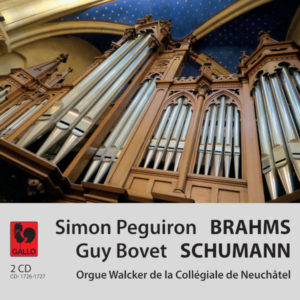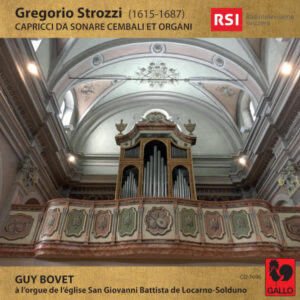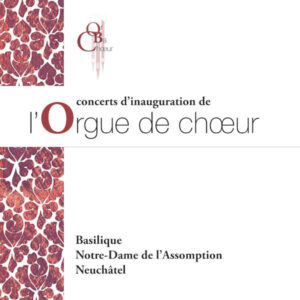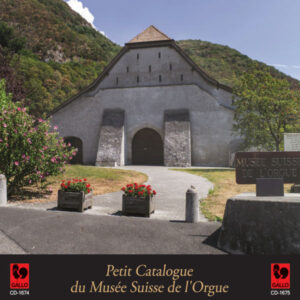Extraits / Excerpts
Bach: Prelude and Fugue, BWV 552 - Franck: Choral No. 2 in B Minor, FWV 39 - Brahms - Pierre Segond at the Great Organ of Saint-Pierre Cathedral in Geneva.
Johann Sebastian BACH: Prelude and Fugue in E-Flat Major, BWV 552: I. Prelude – II. Fugue – Ach bleib bei uns, Herr Jesu Christ, BWV 649 – Wachtet auf, ruft uns die Stimme, BWV 645 – Johannes BRAHMS: 11 Chorale Preludes, Op. 122: No. 7 O Gott du frommer Gott – No. 5 Schmücke dich, O liebe Seele – No. 10 Herzlich tut mich verlangen – César FRANCK: Choral No. 2 in B Minor, FWV 39
Pierre Segond at the Great Organ of Saint-Pierre Cathedral in Geneva. (Biography)
THE WORKS
Like the first record published by — and for — the “Fondation des Clefs de Saint-Pierre”, this one presents works by some of the greatest composers: works that reveal the beauty and rich sound of the organs of Geneva Cathedral; works so familiar to music lovers that long commentary seems unnecessary.
Side 1 will be dedicated to J.S. Bach, side 2 to Brahms and Franck.
SIDE 1
“The Cantor of Leipzig appears like a kind of beacon illuminating all organ music,” said French musicologist Norbert Dufourcq about Johann Sebastian Bach (1685-1750).
From his considerable body of work, we highlight three pieces: a Prelude and Fugue, and two Chorales.
The Prelude and Fugue in E-flat major forms the most imposing diptych of his oeuvre. The prelude introduces, and the fugue crowns the set of twenty-one chorales known as the Lutheran catechism. It is certain that this diptych held, in Bach’s mind, a primarily Trinitarian symbolic meaning, clearly seen in the fugue’s three parts and three themes, with the first combining successively with the other two. Transcendent writing, royal architecture… and continuous-flowing music!
Among the two chorales that follow, one will admire, among other qualities, the transparency of the writing, first in two, then in three voices. These are organ adaptations by the composer himself, from excerpts of two of his Cantatas. The texts, sung by a soloist in the Cantatas, refer, one to the episode after Christ’s Resurrection of the disciples from Emmaus (Ach, bleib bei uns, Herr Jesu Christ), the other to the parable of the wise and foolish virgins (Wachet auf, ruft uns die Stimme).
SIDE 2
Johannes Brahms’ (1833-1897) organ works are not abundant: about fifteen pieces, enough for three record sides. But we are fortunate they exist, for they are worthy of their creator in every way!
His eleven Choral Preludes — three of which are featured on this recording — were written at the end of his life, when, affected by the death of Clara Schumann and sensing his own approaching, he felt the need to meditate on the great mysteries of life and the afterlife. Perhaps he also returned to studying J.S. Bach’s organ chorales, which he had played forty years earlier.
The organ held an important place in César Franck’s (1822-1890) life — he was organist at the Basilica of Sainte-Clotilde in Paris for over thirty years — and in his musical output. Of the three great Chorales, his final compositions, it is the second, in B minor, that, according to his direct disciples, the composer preferred. Likely for both the unity of its musical thought and the simplicity, purity of its form — two large sections separated by a sort of recitative, each crowned by an entirely seraphic phrase in major.
But let’s stop this commentary here. Wasn’t it Beethoven who said: where words leave off, music begins?
- Categories
- Composers
- Interprets
- Booklet












